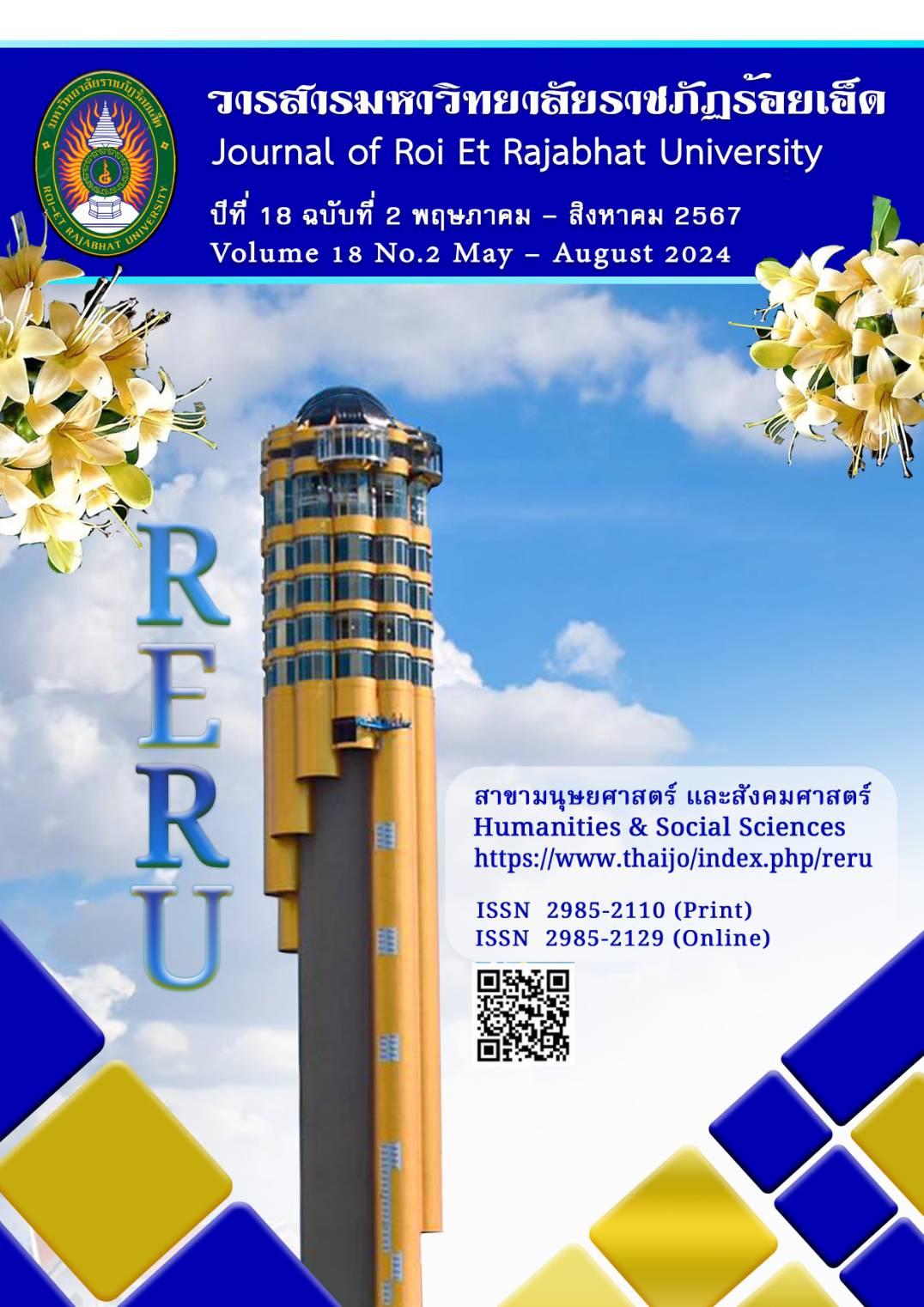The Long-Run and Short-Run Equilibrium Relationships between Income Inequality and Educational Inequality: A Case Study of Thailand
Keywords:
Income inequality, Education inequality, Equilibrium relationshipAbstract
This paper aimed 1) to examine the causal relationship between income inequality and educational inequality and 2) to investigate the long-term and short-term equilibrium relationships between income inequality and education inequality in Thailand by using secondary data from 1960 to 2021. In this study, we utilized 1) The granger causality test, 2) The cointegration test, and 3) The error-correction model (ECM) to estimate this relationship. The results indicated that income inequality and educational inequality had a causal relationship with each other. From the equilibrium relationship test found that both variables used in the study showed the long-term and short-term equilibrium relationships. To clarify, an increase in Thailand’s income inequality will increase Thailand’s educational inequality and vice versa. As the economic structure of Thailand is classified as a middle-income country, the majority of income is concentrated among high-income individuals. This leads to vulnerable people with low incomes being unable to access basic educational rights. Therefore, the government should implement tax policies to promote income redistribution and provide appropriate social welfare for low-income groups.
References
กัลยา วานิชย์บัญชา. (2546). การวิเคราะห์สถิติ: สถิติสำหรับการบริหารและการวิจัย (พิมพ์ครั้งที่ 7). กรุงเทพฯ: จุฬาลงกรณ์
มหาวิทยาลัย.
กองทุนเพื่อความเสมอภาคทางการศึกษา. (2563). การศึกษาโลกสะท้อนไทย ความเหลื่อมล้ำที่ยังไม่หายไป. สืบค้นเมื่อ 7 พฤศจิกายน 2566, จาก https://www.the101.world/global-and-thai-education/
กองทุนเพื่อความเสมอภาคทางการศึกษา. (2565). เปิดรายงานสถานการณ์ความเหลื่อมล้ำทางการศึกษา. สืบค้นเมื่อ
พฤศจิกายน 2566, จาก https://thevisual.thaipbs.or.th/equality/dropout/situation2022
คัทลียา จิตรัตน์ และสมพร ปั่นโภชา. (2566). วิเคราะห์โอกาสในการทำกำไรจากกลยุทธ์ Pair Trading ในตลาดแลกเปลี่ยน
เงินตราต่างประเทศ โดยการทดสอบความสัมพันธ์เชิงดุลยภาพในระยะยาว. In Rangsit Graduate Research
Conference: RGRC, 18, 261-273.
ทิพย์พาพร ตันติสุนทร. (2562). การลดความยากจนและความเหลื่อมล้ำทางการศึกษา. สืบค้นเมื่อ 14 พฤศจิกายน 2566,
จาก https://www.csdi.or.th/wp- content
ธนาคารโลก. (2566). ข้อมูลทุติยภูมิ. สืบค้นเมื่อ 11 กุมภาพันธ์ 2566, จาก https://data.worldbank.org/
มัทยา บุตรงาม. (2555). ความสัมพันธ์ระหว่างความเหลื่อมล้ำทางการศึกษาและความเหลื่อมล้ำทางรายได้ในประเทศไทย.
วิทยานิพนธ์ บริหารธุรกิจมหาบัณฑิต สาขาวิชาเศรษฐศาสตร์. กรุงเทพฯ: จุฬาลงกรณ์มหาวิทยาลัย.
มูลนิธิยุวพัฒน์. (2566). คลื่น “ความเหลื่อมล้ำ” ทางการศึกษา ซัดเด็กไทยให้หายไประหว่างทาง ความยากซ้ำเติม “เด็กหลุด จาก
ระบบ”. สืบค้นเมื่อ 8 พฤศจิกายน 2566, จาก https://www.yuvabadhanafoundation.org/th
วรรณพงษ์ ดุรงคเวโรจน์. (2564). ความเหลื่อมล้ำโลก (Global Inequality) และการเปลี่ยนแปลงหลังโควิด. สืบค้นเมื่อ
พฤศจิกายน 2566, จาก https://www.the101.com
วริฤฐา บุญทนาวงค์. (2562). ปัจจัยที่มีผลกระทบต่อความเหลื่อมล้ำทางรายได้ของประเทศไทย. วิทยานิพนธ์ เศรษฐศาสตร มหาบัณฑิต. กรุงเทพ: มหาวิทยาลัยเกษตรศาสตร์
สหประชาชาติ. (2566). เป้าหมายที่ 10: ลดความไม่เสมอภาคภายในประเทศและระหว่าง. สืบค้นเมื่อ 10 พฤศจิกายน 2566, จาก https://www.sdgmove.com/2021/05/25/
สามารถ จันทร์สูรย์, ศุภกร คุรุการเกษตร และอภิชาติ มหาราชเสนา. (2564), กลยุทธ์การจัดการศึกษาเพื่อแก้ปัญหา
ความเหลื่อมล้ำและความยากจน. วารสาร มจร การพัฒนาสังคม, 6(1), 111-126.
Adegun, E. A., Olasupo, S. F., Aransiola, I. J., Kalejaiye, T. G. and Aderemiq, T. A. (2023). Role of Female Labour Participation in Reducing Income Inequality in ECOWAS Sub-Region. Izvestiya. Journal of Economics, Management and Informatics, 67(1), 60-79.
Ali, A. K. and Asfaw, D. M. (2023). Nexus between inflation, income inequality, and economic growth in Ethiopia. Plos one, 18(11). https://doi.org/10.1371/journal.pone.0294454
Angeles, A. C., Donaire, S. J., Reyes, R. B. and Cabauatan, R. (2021). The effect of gender inequality in education, labor force participation and economic opportunity on the income distribution of India. Journal Studi Guru dan Pembelajaran, 4(3), 781-794.
Azizah, S. N., Fauziyyah, N. E. and Qoyum, A. (2019). Short-run and Long-run Relationship between Economic Growth, Foreign Direct Investment, Trade Liberalization and Education on Income Inequality: Evidence from Indonesia. Journal of Islamic Finance, 8, 047-055.
Credit Suisse, (2022). Global Wealth Report 2023. Retrieved January 21, 2023, From https://www.credit-suisse.com/about-us/en/reports-research/global-wealth-
Crossman, A. (2021). The sociology of social inequality. Retrieved February 16, 2023,
From https://soc37.commons.gc.cuny.edu/wp-content/blogs
Deshpande, A., Goel, D. and Khanna, S. (2018). Bad karma or discrimination? Male–female wage gaps among salaried workers in India. World Development, 102, 331-344.
Engle, R. F. and Granger, C. W. J. (1987). Cointegration and error correction: representation, estimation and testing. Econometric, 55(2), 251-276.
Garcias, M. O. and Kassouf, A. L. (2021). Intergenerational mobility in education and occupation and the effect of schooling on youth’s earnings in Brazil. Economic, 22(2), 100-113.
Granger, C. W. J. (1969). Investigating causal relations by econometric models and cross-spectral methods. Econometric, 37(3), 424-438.
Kuznets, S. (1995). Economic Growth and Income Inequality. American Economic Review, 45(4), 1–28.
Pesaran, M. H. (2007). A simple panel unit root test in the presence of cross‐section dependence. Journal of applied econometrics, 22(2), 265-312.
Rahman, A., Tanjung, A. A., Ramli, R. and Arif, M. (2023). Determinants of income inequality in a time perspective in Indonesia. Economics Development Analysis Journal, 12(2), 231-242.
Shen, C. and Zhao, X. (2023). How does income inequality affect economic growth at different income levels? Economic research-Ekonomska istraživanja, 36(1), 864-884.
Downloads
Published
How to Cite
Issue
Section
License
Copyright (c) 2024 Roi Et Rajabhat University

This work is licensed under a Creative Commons Attribution-NonCommercial-NoDerivatives 4.0 International License.
บทความที่ได้รับการตีพิมพ์เป็นลิขสิทธิ์ของวารสารมหาวิทยาลัยราชภัฎร้อยเอ็ด
ข้อความที่ปรากฏในบทความแต่ละเรื่องในวารสารวิชาการเล่มนี้เป็นความคิดเห็นส่วนตัวของผู้เขียนแต่ละท่านไม่เกี่ยวข้องกับมหาวิทยาลัยราชภัฎร้อยเอ็ด และคณาจารย์ท่านอื่นๆในมหาวิทยาลัยฯ แต่อย่างใด ความรับผิดชอบองค์ประกอบทั้งหมดของบทความแต่ละเรื่องเป็นของผู้เขียนแต่ละท่าน หากมีความผิดพลาดใดๆ ผู้เขียนแต่ละท่านจะรับผิดชอบบทความของตนเองแต่ผู้เดียว





